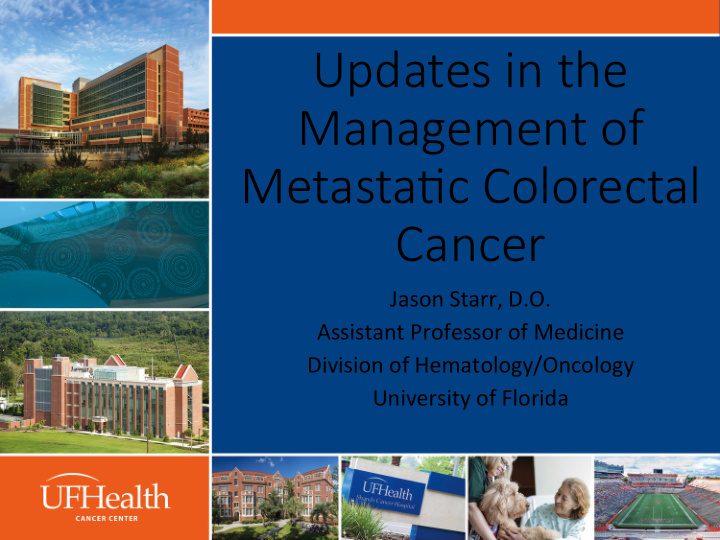



Updates in the Management of Metasta1c Colorectal Cancer Jason Starr, D.O. Assistant Professor of Medicine Division of Hematology/Oncology University of Florida
Disclosures • Consultant: Celgene (advisory board)
ObjecFves • Review importance of all RAS tesFng • Review current role of microsatellite/ mismatch repair tesFng • Review current role of immunotherapy • Review importance of “sidedness”
Breakdown of MutaFons . HER-2 5% KRAS WT KRAS exon 2 40% 40% KRAS exon 2 mutaFon KRAS/NRAS mutaFon BRAF V600E BRAF KRAS/NRAS KRAS WT 10% 5% HER-2
Molecular MutaFons in The Colon Occur Along a Spectrum *Courtesy of Dr. Mohamed Salem
Epidermal Growth Factor Receptor As a Target • EGFR anFbodies were iniFally chosen because of high expression (60-80%) in CRC • EGFR is also involved in canonical signaling in the KRAS pathway Walther. Nature Reviews Cancer. 2009
RAS – Historically Speaking • Early phase 1 and 2 studies showed cetuximab (BOND trial) to have acFvity when added to irinotecan- and oxaliplaFn-based therapy • This led to mulFple first-line phase III trials incorporaFng cetuximab (CRYSTAL, OPUS, CAIRO2) and panitumumab (PRIME) with chemotherapy. • These trials showed that EGFR Ab added to chemo were either negaFve or only marginally effecFve.
RAS – Historically Speaking • It was only later on post-hoc analysis of the previously noted that the benefit of EGFR anFbodies was noted to be restricted to paFents who were KRAS wild-type (WT) • Some translaFonal work by Khambata-Ford and colleagues showed further evidence that KRAS WT paFents were more likely to respond to cetuximab
All RAS, All The Time • Extended RAS was then analyzed in two of the large clinical trials (PRIME and CRYSTAL) incorporaFng EGFR Abs • This included: • NRAS exons 2 (codons 12 and 13), 3 (codons 59 and 61) and 4 (codons 117 and 146) • KRAS exons 3 and 4 • RestrospecFve analysis showed staFsFcally significant lack of benefit from EGFR Abs in this subset of paFents.
But Don’t Take My Word For It
HER-2 AmplificaFon 5% of metastaFc CRC paFents with HER-2 amplificaFon • HERACLES study evaluated 27 heavily pretreated CRC paFents • with HER-2 amplificaFons. PaFents were treated with trastuzumab and lapaFnib • ORR 30% with 45% of paFents alive at one year • Data suggests this is another subset of paFents that does not • benefit from EGFR Abs Unclear if response includes HER-2 acFvaFng mutaFons •
Mismatch Repair/Microsatellite Status • It is has been observed for many years that certain tumors have a brisk lymphocyFc infiltraFon surrounding the malignant cells • IdenFfied that many of these paFents lacked mismatch repair proteins (dMMR) and exhibited microsatellite instability high (MSI-H) genotype. • Up to 15% of sporadic (i.e. not HNPCC) stage II/III CRC exhibits these molecular features. • Only 5% of paFents are dMMR/MSI-H in the metastaFc selng.
InterpreFng Mismatch Repair/ Microsatellite Status • MMR gene status can be assessed by presence or absence of protein expression via IHC • These include: MLH1, MSH2, MSH6 and PMS2 • MSI status is assessed via PCR which is designed to amplify a standard panel of DNA sequences containing known nucleoFde repeats • If 30% or more of the markers show expansion or contracFon in the tumor compared to normal mucosa the tumor is deemed to be MSI-H
MMR IHC TesFng PROS CONS Readily available and easy to Requires careful quality perform control Inexpensive Patchy staining (esp. MSH6) Picks up loss of expression of DefecFve MMR may sFll be PMS2 and MSH6 which can be anFgenic missed by PCR MSI tesFng SensiFvity 83-90% Specificity 89% Directs subsequent gene sequencing
MSI TesFng PROS CONS Commercial kit available Expensive >90% sensiFve Requires specialized lab DetecFon independent of Requires both tumor and affected MMR protein loss normal samples May be less sensiFve to MSH6 loss
Further evidence for PD-1 in dMMR/ MSI-H • Checkmate 142 is evaluaFng heavily pre-treated MSI-H /dMMR metastaFc CRC paFents with either nivolumab or nivolumab + ipilimumab. • Updated was recently presented at 2017 GI Symposium and revealed 31% response rate with 83% responses ongoing at a median follow up of 7.4 months. • Median PFS was 9.6 months and median OS not reached
PD-1 for MSI-H/dMMR • Needless to say I would advocate for MMR/MSI tesFng for all paFents with metastaFc CRC
More Immunotherapy Trials • KEYNOTE-177 • Stage IV CRC w/ MSI-H/dMMR • First line phase III, randomized, open-label, two- arm, controlled clinical trial comparing pembrolizumab monotherapy to standard chemotherapy in the first line selng • AVAILABLE AT UF • NRG GI-004
What about my paFents without MSI-H/dMMR tumors? • There is a concerted effort to turn normally immune- quiescent tumors into ones that are immunogenic • Preclinical data showed that MEK inhibiFon in combinaFon with PD-L1 blockade promoted immune acFvaFon via CD8 + effector T-cells * • This led to a phase Ib study of 23 previously treated MSS/MMR-P KRAS mutated metastaFc CRC paFents. • The response rate was 17% with stable disease in 22% * Ebert, et al. Immunity. 2016
What about my paFents without MSI-H/dMMR tumors? • This has led to a phase III trial invesFgaFng atezo/cobi, atezo alone, or regorafenib alone in previously treated metastaFc CRC • Stay tuned!
Who’s Side Are You On Anyways?
QuesFons Thank you for your Fme and arenFon
Recommend
More recommend